Cat Breeds & More
Here you will find some interesting information about the most popular cat breeds, their personality, health and basic care. Our goal is to provide you with information that can help you to find the perfect cat to match your family and life style.
Breeds are normally divided into two major categories, they are: the long-haired and the short-haired cats.
Breeds quick access: Abyssinian : Burmese :
Cornish Rex : Devon Rex : Egyptian Mau : Himalayan : Maine Coon : Manx : Persian : Russian Blue : Siamese : Non-pedigree
Abyssinian
The Abyssinian is one of the oldest domesticated cat breeds. They are very athletic, active and curious cat - this is no lap cat.
Facts about the Abyssinian:
• They look like a wildcat, the Abyssinian has an unique thick short coat, which comes in a bevy of colors, such as: ruddy, chocolate, cinnamon, blue, lilac, reddish, and fawn.
• The Abyssinian is a very intelligent cat and a quick learner. They excel at learning tricks.
• They don't mind living in a single-animal house, but they will do best with a person or family who spends a lot of time at home. They will need a lot of human interaction in order to stay out of trouble.
• The Abyssinian can develop a hereditary condition called Pyruvate Kinase (PK) deficiency, which can cause intermittent anemia. Your Vet can perform a DNA test, and determine whether your cat is normal or a carrier of such disease. Signs of such disease includes, depression, lack of appetite, pale gums, and enlarged abdomen. Although, offspring of cats with such illnesses can be born without the disease.
• Another health concern about the Abyssinian is that they may develop periodontal disease. Make sure you brush your cat's teeth regularly.
The
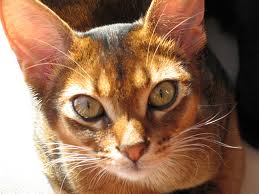

The
Burmese
The Burmese is very social cats who excel on the companionship of its family or other pets. They are very smart and vocal cats.
Facts about the Burmese:
• The Burmese is a very sweet, outgoing and entertaining cat. Burmese are very patient cats and will do well around kids. They don't like to be left alone, so if you are thinking of adopting a Burmese, be sure that he/she will not be home alone all day.
• They have short, fine silky coat which comes in the original dark sable brown, and other solid colors such as: light brown, blue and lilac.
• The Burmese thrive on attention and will follow you around when you are home and love to curl up on your lap.
• They are very intelligent cats, so they are easy to train. You can even teach them to play with puzzle toys that will reward them with treats once they learn to manipulate them.
• Burmese are generally healthy, although like many other breeds, they are prone to health issues. They can born with cranial deformities, periodontal disease, breathing difficulties due to short muzzles, or small patches of skin and hair attached to the cornea. If you are getting a Burmese from a breeder be sure to ask for a written health certificate.
• The Burmese does not shed much, weekly brushing or combing is all what your cat will need. Also make sure that you trim his/her nails and clean his/her ears once a week.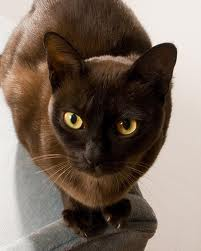

The
Cornish Rex
The Cornish Rex is a small to medium-size cat with a distinctive curly coat. The Cornish Rex is also a popular and friendly cat breed.
Facts about the Cornish Rex:
• They have an unusual wavy coat, which comes in many colors and patterns (including bi-color). The Cornish Rex has an egg-shaped head, curly whiskers, large ears, big eyes, and long hind legs.
• The Cornish Rex is very intelligent, highly active that loves to be involved in everything you're doing. They are fast learners, they can be easily trained. Make sure you challenge his brain by teaching him tricks and providing him with puzzle toys that will reward him with treats as soon as he learns to manipulate them.
• They can adapt easily to a new home, family members, and other pets. They are very social and loves to be the center of attention.
• Cornish Rex don't do well on their own, so if you need to leave your cat alone for long periods of time, make sure you get him a companion cat to interact with him.
• They require almost no grooming at all. They hair is very delicate, and brushing or combing can damage it, so the less is better. The only other care your Cornish Rex will need is the weekly nail trimming and occasional ear cleaning. While cleaning their ears and paws, make sure you use a damp cotton wool - these areas tend to get greasy. Also make sure that there is no redness or bad odor inside his big ears, that could indicate an infection.
• For the most part, the Cornish Rex is a health cat. Although his coat offers little protection from the sun's rays, so keep your cat indoors. They may also be prone to hereditary baldness, so make sure you get a written health guarantee from your breeder.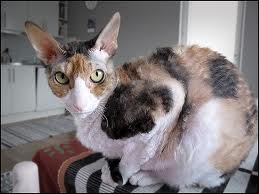

The
Devon Rex
Devon Rex are highly intelligent and super active cats, where their actions can sometimes resemble a pixie (little troublemakers). The popular Devon Rex has a wavy coat, like their cousin, the Cornish Rex.
Facts about the Devon Rex:
• They have big eyes, huge ears, high cheekbones, slender body, long legs and wavy hair. The Devon Rex is a small to medium size cat, well-muscled and very athletic. They come in a variety of patterns and in colors, including pointed solid, shaded, tortoiseshell, calico, bi-color, smoke colors, as well as the tabby pattern.
• The Devon Rex is a very active cat, they can jump great heights and they love to learn new tricks - they can even learn to play the piano. To keep your Devon Rex out of trouble, you will need to challenge his brain by teaching him tricks and providing him with puzzle toys that will reward him with treats once he learns how to manipulate them.
• They are very social and people-oriented cats, their outgoing nature makes them a good choice for families with older kids, other pets, or frequent guests. They are also excellent traveling companion.
• The Devon Rex don't like to be alone. If you need to leave your Devon Rex alone for long periods of time, make sure you get him a companion cat or that you have another pet in your house.
• The Devon Rex does not make many sounds to communicate with you, but they will make a soft chirping sound when they want to get your attention.
• They are generally healthy, but they may have a few hereditary health issues that you should know. They are: Hypertrophic Cardiomyopathy (heart disease that causes enlargement of the heart muscle), Patellar Luxation (occasionally the kneecap poops out of place, causing the cat to limp or hop), Myopathy (a condition that affects muscle function), and hereditary baldness. Be sure to ask your breeder to show evidence that your kitten's parents have been screened for heart murmurs and patellar luxation. Also ask for a written health guarantee. Your Vet can also perform tests to determine the health of your cat.
• Grooming is easy as their coat doesn't shed much. Be very gentle while grooming your Devon Rex, they have delicate hair, and rough brushing or combing can damage it. Bathing your Devon Rex every few weeks is also recommended due to the fact that they develop a greasy feel, especially in folds or on the paws. The rest is basic care.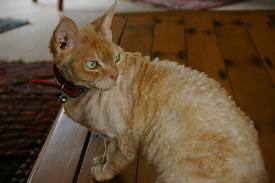

The
Egyptian Mau
The Egyptian Mau is also very intelligent and loyal cat. This cat breed loves his family and the affection he will get from them.
Facts about the Egyptian Mau:
• The Egyptian Mau is the only domesticated cat with a naturally occurring spotted coat. They have a medium length coat and you can find them in three colors: smoke, bronze and silver. The "M" shape on the forehead is called the mark of the scarab.
• They are very active, quick learner and observant. Their front legs are shorter than their hind legs, giving them a characteristic tippy-toe stance.
• Egyptian Mau communicate enjoyment and satisfaction by wagging its tail, kneading paws and by making sounds that chortles and trills.
• Generally the Egyptian Mau is a healthy cat, but they can develop a hereditary condition called hypertrophic cardiomyopathy. This is a common form of heart disease in cats that causes enlargement of the heart muscle. Your Vet can perform a test and determine if your cat has this disease or
not.
• Egyptian Mau grooming will require weekly brushing to keep the coat shinny and healthy and regular nail trimming. Remember to clean your cat's ears, and brush its teeth for good overall health and fresh breath.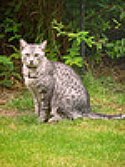

The Himalayan
The Himalayan combines the best of two very different breeds, the Persian and the Siamese. They have the body and coat of the Persian and the colors and patterns of the Siamese.
Facts about the Himalayan:
• The Himalayan has long and beautiful coat with many different colors and patterns, and like the Persian cat, they have small ears, large round eyes, a snub nose and an adorable face. Their size varies from medium to large.
• They are very sweet and have a calm personality. They are not very active and love a lap. They are also quite independent, they will entertain themselves, although they are not jumpers or climbers, so you do not to worry about them climbing on top of your fridge or cabinets.
• The Himalayan is a smart cat and can adapt to new home and people easily, just make sure that your feline friend has the attention he needs during this transition. They will do best in homes with older children.
• Although the Himalayan cat does not demand attention, he will communicate with you by a making a low meow and look, which means that he wants attention.
• The Himalayan also has some hereditary health issues. They include: Polycystic Kidney disease (PDK) - condition causing enlarged kidneys and kidney dysfunction, excessive tearing of the eyes and respiratory problems. Be sure to ask the breeder for proof that both of a kitten's parents are disease free, and ask your Vet to perform the proper test to check the health of your new cat.
• They will require a lot of grooming time in order to maintain its beauty. You will need to brush his hair daily in order to prevent and remove mats and tangles. You should also bath him regularly, so start bathing your kitten as soon as you bring him home, this way he will get used to water. You will also need to wash your cat's face daily to prevent stain under his eyes.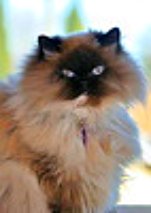

The
Maine Coon
The Maine Coon is a plus size cat and is likely the oldest cat breed native to America. They are very friendly, people-oriented and curious cat. They can make a tremendous companion for large families.
Facts about the Maine Coon:
• The Maine Coon will get along with everyone, including kids, dogs and other cats. They love their family but are not going to demand attention.
• They come in several patterns and colors, but the most common is the brown or mackerel tabby. They also have large and expressive eyes.
• The Maine Coon can adapt very quickly to any type of home and climate.
• They certainly can entertain themselves, but they also like to get attention from you. They enjoy playing fetch and can also learn new tricks.
• There are three main genetic health concerns that you should know about the Maine Coon. They are hypertrophic cardiomyopathy (heart disease), hip dysplasia (defect of the hip socket), and spinal muscular atrophy (caused by the loss of spinal cord neurons that activate skeletal muscles of the
trunk and limbs, causing muscle weakness and degeneration). Your Vet can test your cat for such diseases.
• Weekly combing is all what your Maine Coon will need, their hair will rarely mat. By combing your cat's hair regularly will help to prevent hairballs. And, you will need to trim your cat's nails every two weeks.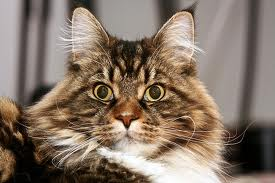

The
Manx
The Manx is very friendly and affectionate cat. They are best known for being tailless or having a stumpy tail. The Cymric is the long-haired version of the Manx, other than the coat length they are pretty much identical.
Facts about the Manx:
• The Manx has a medium size with rounded bodies, rounded head, and rounded eyes.
• They come in a variety of colors and patterns, such as: shaded silver, black smoke, blue smoke, classic tabby pattern, black, blue, cream, tortoiseshell, and bi-color.
• The Manx are not completely tailless, some have up to three vertebrae fused at the end of the spine, and others have a stump - normally, shorter than the typical cat tail. Make sure that you support the hindquarters to reduce the pressure of the spine of your cat while you or anyone else is picking the cat up.
• This breed is very sweet and people-oriented. The adapt to a new home and family members quickly.
• Some of them tend to devote their love to a single family member, others will proclaim their love to the entire family - kids included!
• The Manx is very intelligent, which will make it easy for you to train your new cat. They also love to learn new tricks.
• You should also know that the Manx may have genetic health issues due to the fact that they do not have a full size tail like most cats. Some have spinal defects that cause neurological disorders. This illness can surface at early age. Make sure your breeder provides a written health guarantee.
• The Manx requires that you brush or comb their body once or twice a week to remove dead hair, clean ears occasionally and trim his nails weekly. During shedding seasons (spring and fall) you will need to brush your Manx more often.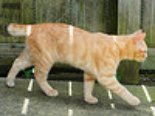

The
Persian
The Persian is one of the oldest and most popular cat breeds out there. They have a beautiful long hair, adorable face and calm personality.
Facts about the Persian:
• There are two types of Persian cats, the show and the traditional. The show Persian has round head with a thick ruff, small ears, flat nose and a broad, short body with a wide, attractive plume of a tail. The traditional Persian has less extreme features of the show Persian, which includes a normal length nose. Both of them have luxurious coat that comes in many colors and patterns.
• They communicate with their expressive eyes and soft voice.
• This is a high maintenance cat, they require daily brushing in order to keep their coat tangle and mat free. In addition to regular bathing - make sure you introduce the bathing part to your kitten as soon as possible so he learns that this is part of their grooming habits. You must also clean
around your Persian's eyes daily.
• The Persian is also a gentle and sweet cat. They prefer peaceful and calm environment, and do not mind spending time alone.
• They are not very athletic, so you will not find your Persian cat on top of cabinets and fridge. Persians prefer to be close to the ground, you will find him resting on your favorite chair, sofa and bed.
• Persians have a restful and easy personality, they love to cuddle, but they are also playful and curious cat.
• Some of the health issues you should know about the Persian cat includes: Polycystic Kidney disease (PDK) and Progressive Retinal Atrophy (PRA). PDK is a hereditary condition causing enlarged kidneys and kidney dysfunction. PRA is also a hereditary condition that causes vision problems that can start at early age and it progresses quickly. Make sure to ask your breeder about the written health guarantee. Your Vet can also perform test to verify the health of you Persian cat.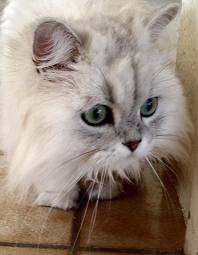

The
Russian Blue
The Russian Blue is a gentle, calm and very intelligent cat. Russian Blue love to play with a variety of toys and are very loyal to their loved ones. They also come in a long-haired variety known as the Nebelung.
Facts about the Russian Blue:
• The Russian Blue and the Nebelung have the same affectionate, reserved temperament and easy going nature. They like routine, so make sure you keep their feeding, napping and playing time consistent.
• Russian Blue have a beautiful silvery blue coat, moderately wedge-shaped head, large ears, long legs and body. Their coat is short, thick fur and soft to touch. The European Russian Blue tend to be a bit larger than the American Russian Blue. White and Black Russian, also called Russian Short-hair, are recognized by the Australian and New Zealand registries.
• They can be a little shy, so make sure you get your Russian Blue from a breeder or rescue centers who gives their cats plenty of handling from day one. This breed is well suited to any home with people who will love him. They do best with older kids who won't scare him.
• The Russian Blue will get along with young children or cat-friendly dogs, if he is raised with them. They love to play with feather toys and are a quick learner - they can easily figure out how to get into cabinets and open doors. They also love to jump and climb.
• They are not stranger friendly, but if your Russian Blue has been socialized from an early age and continued throughout his life, your cat is more likely to enjoy interaction with people and traveling.
• Grooming your Russian Blue is very easy, just comb or brush his thick hair once or twice a week. If you have the long-haired Nebelung brush or comb him twice a week. Also trim his nails as needed.
• The Russian Blue has great health and is not known to have any hereditary problems.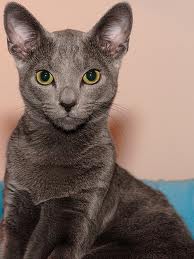

The
Siamese
The Siamese is one of the oldest and well-known cat breed. They are very curious, vocal and people orientated cat.
Facts about the Siamese:
• The Siamese is a beautiful light-colored cat with striking color points in brown, lilac, seal and blue - as well as tabby, red, cream, silver and smoke. They come in two types: show and traditional. The show Siamese has a tubular body on long legs, wedge-shaped head with large ears, and a long
tail. The traditional Siamese has a rounded head and a chunky body. Both types will share the same wonderful personality.
• They are extremely curious, smart and demanding. The Siamese is people-oriented, good around kids and a very loyal companion. They love to be part of everything you do around the house.
• The Siamese is very vocal, they will "talk" with you all day long. They like to be the center of attention, but they will do well with dogs and other cats.
• They are fast learners, provide your Siamese with toys and puzzle toys that require him to think and move to release treats. They also love to fetch and you can also teach him to walk on a leash. With a little training, your Siamese can also learn to run an agility course.
• You shouldn't leave your Siamese alone, not even for a short while. If you cannot give your Siamese all the attention that he needs, make sure that you get him a companion.
• In general they have a good health, but there are a few hereditary health issues that you should know. Siamese cats with a wedge-shaped head are more prone to respiratory and dental issues than cats with less extreme head type. They may also have problems with crossed eyes or a kinked tail.
• Their short coat is easy to groom, just brush or comb once a week. The rest is basic care.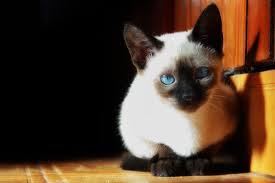

For a complete list of cat breeds, click here.
Non-pedigree Cats.
The non-pedigree cats are cats that have one or both parents cross-breeds themselves. They are also called "moggies."
Since they have been mixed it is difficult to predict their temperament or possible genetic health issues - generally they have few health issues. For the most part they are very affectionate, people-oriented and good around other pets. If you are bringing home a non-pedigree cat make sure you give your cat attention and care as if you have a breed cat.
Both of our cats are non-pedigree and they are amazing! Our female cat had a few health issues during her young years, but now she is quite healthy. She is a medium size cat, has large dark green eyes, rounded ears, black and white hair (tuxedo), and does not communicate vocally as much.
Our male cat has a very different personality. He is very active, playful, and vocal. He has a lean body, green eyes, gray tabby color. They both are short haired cats, very sweet and smart, they can learn tricks and even learn to walk on a leash.
Like many other cat breed, if you are going to leave your cat alone for long periods of time, make sure you get him a companion cat (if possible, adopt two cats from the same litter or rescue organization), so he or she does not get bored or sad.
Non-pedigree cats are low maintenance companion. Weekly brushing or combing, trimming of nails and bathing as needed.
Moggies are very loyal cats and loving companion to any household.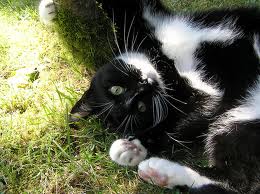
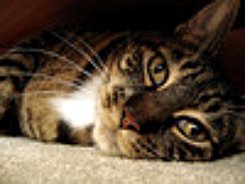
Choosing a cat breed or non-breed.
Before you contact a breeder or a cat rescue organization regarding adopting or purchasing a cat, make sure you do your home work first. From learning about cat breeds - or non-breeds, and determining which one will best match your life style, to getting references regarding the breeder you are planning to get your kitten from. Rescued cats, no matter their pedigree will love to find a home, so give them a chance and they will love to be your companion cat.
Remember, pedigreed cats are prone to certain hereditary illnesses, so if a breeder claims that their breed has no health or genetic problems, they are not been honest or don't have enough knowledge about the breed. Stay away from such breeders.
It is also preferable that you choose a kitten from a breeder who raises their litter at home and handle their cats from an early age. Make sure you meet the kitten's parents to ensure that they have nice personalities.
Always ask the breeder to show evidence that the kitten's parents are checked annually for health issues due to the specific cat breed, and also ask the breeder to provide a written health certificate/guarantee.
Tell Us About Your Cat or Kitten And Share Photos!
Send us pictures and tell us all about your cat or kitten! Please be sure to submit at least 400 words, as it will make for a better page. I will have to delete pages which are shorter I'm afraid.
See More Contributions.
Click below to see contributions from other visitors to this page...
50 Shades of Purrrr 




It may shock you to know that my eight year old male cat, Seiko, nurses on himself. And his sister, Suki, nurses on him at the same time. They have been …
Aja 




Aja is only 3 months old, we adopted her and just got her last week. She's very active. She has lbig ears, long and skinny body, gold eyes. Very curious …
Enrico 




Enrico (known as Rico) has been with me a month now, a classic "brindle" tabby. "Free to a good home" I picked him up and was told he was nine weeks old. …
Cocco 




Ever since I got my cat Cocco 11 years ago when he was 6 weeks old, I've always wondered what kind of cat he is. It's been bugging me, lol, Cocco has bright …
TJ Markos 




What kind of kitty do I have?
He has long legs, short hair, 21 lbs, not very vocal,big ears, loves time alone. Doesn't like to be pet much, barley purrs.. …
Ngeru (Maori name for cat) Not rated yet
She has been with us for at least 2 years now. We adopted her off our neighbors because they were going to leave her before they moved. Ngeru has been …
Ms. Kay A. Clark Not rated yet
"She's too Fat for Me!"
I have two cats. Sebastian is an orange, domestic tabby who is very slight in build, just turned seven years old and Sidney, a …
The Ultimate Yogi, My Cat. Not rated yet
Sally was no stranger to my yoga mat. She had already claimed it as her personal scratching post, bed, and now: litter.
It was during Downward-Facing-Dog …
Claude Not rated yet
Claude is a non pedigree kitty I found by a bank alone. He looked about 4-6 weeks old. He is white with black spots and has hazel or green eyes. He is …
Dizzy Not rated yet
My sweetheart 8 year old female tuxedo. Classic traits. Rambunctious, independent, but follows me everywhere. Tries to break into my room if I'm in there …
Enzo Not rated yet
Enzo came to me a month ago at around 11 weeks of age. He in a ginger male with beautiful markings. "Free to a good home" Enzo has quickly endeared himself …
alan rose bruce (female) Not rated yet
She loves the treats I made her, she is a very playful very ongoing cat she is also a trouble maker at times!!!
Munchkin Not rated yet
He is nearly two years old and he is a tabby. Munchkin hardly ever stays in the house as he is always wondering around the fields where I live.
He …
Shadow Not rated yet
Shadow is very sweet, loving, and companionable. She loves the lap, but is content to sit by me if the lap is not available. She is an excellent supervisor …
Related Articles
The Best Cat Breeds For Apartment Living
Beginners Guide to Adopting a Cat
"I have studied many philosophers and many cats. The wisdom of cats is infinitely superior." - Hippolyte Taine
"If there were to be a universal sound depicting peace, I would surely vote for the purr." - Barbara L. Diamond
"The key to a successful new relationship between a cat and human is patience." - Susan Easterly
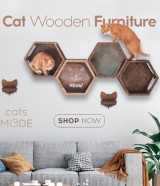





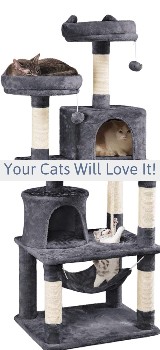

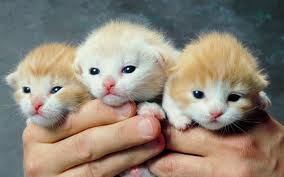
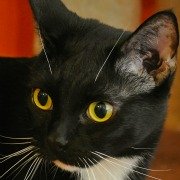

New! Comments
Have your say about what you just read! Leave me a comment in the box below.